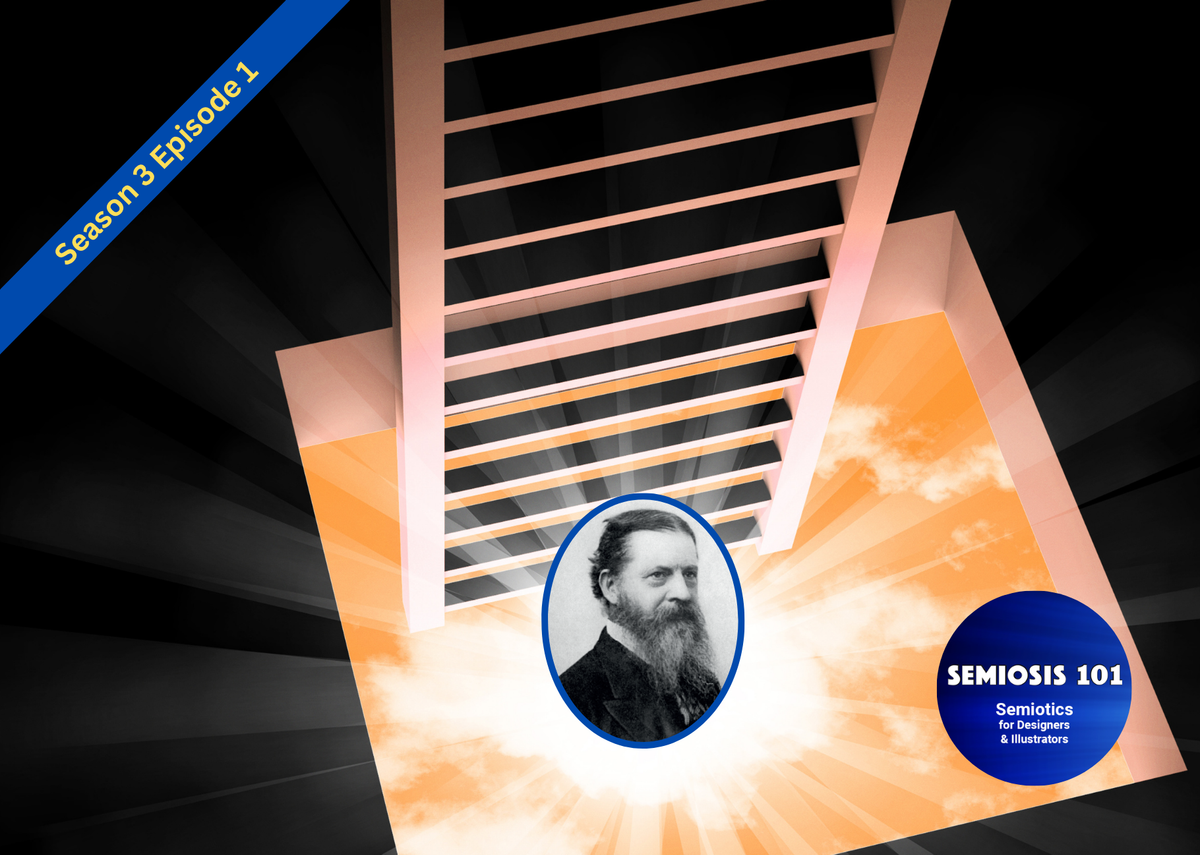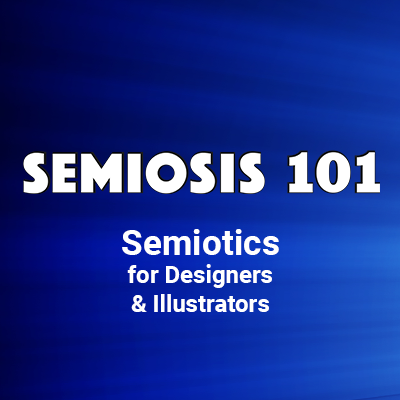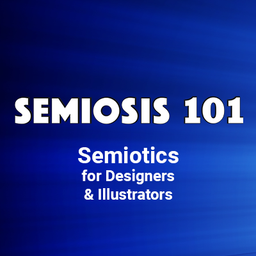Free Semiosis 101 Transcript 3.1:

SEMIOTIC SIGN-ACTION: Encoding Meaning Like YOU Mean It
Hello readers.
In this free transcript for the episode published on Semiosis 101 on 18 Oct 2023, we will discuss creatives getting to grips with semiotics. I will manage creatives’ expectations that a “semiotic sign” is a tangible thing they have to create from scratch.
Watch the free episode on YouTube for the full impact…
…and here is the episode’s transcript.
In this first episode of the new season we will prepare the ground for the Encoding Semiotics theme. One of the initial stumbling blocks for creatives getting to grips with semiotics is their expectation that a “semiotic sign” is a tangible thing they have to create from scratch, which is obviously “a sign.” This confusion with signage is not helpful. Let me put it right. Hit subscribe to this YouTube channel, and I will explain…
In season two we spent a lot of video hours framing semiotics around what the target audience will recognise. Charles Sanders Peirce does state that, “nothing is a [semiotic] sign until it is interpreted as a sign.” So let us quickly unpack that key statement.
It is crucial to changing YOUR framing and understanding of what semiotics IS.
NOTHING…
A SIGN…
INTERPRETED…
Firstly, a semiotic sign is not SIGNAGE. But signage DOES use semiotics. I spent the first episode of season two addressing this so I will not repeat myself. If this riddle is confusing you still, pause this episode and rewatch season two, episode 2.1 Why Semiotic Signs Are Not Signage - But Signage Uses Semiotics! So let us instead focus on nothing/sign/interpreted.
Our keyword here is… perception. The perception of meaning-bearing. Whether you like it or not, whether you realise it or not, and whether you accept it or not, humans can read meaning into anything. We seem hard-wired this way. An evolutional survival trait probably, (my working Hypothesis at play here), that meant we visually scan for patterns and shapes to give us the edge on hunting or fleeing from animals in our distant hunter-gatherer past.
We perceive these shapes and patterns as possible meaning-bearing clues, which will provide us valuable information so we can make decisions and take actions. This is good news for us in the creative industries (and for learning to apply Peirce’s Semiosis), as what we do in Visual Communication Design, in our designs and illustrations, is easier by bringing the audience closer to your ideation phase.
So let us look at the three unpacked words again with this understanding now in place.
NOTHING…
SIGN…
INTERPRETED…
As designers and illustrators we do create something. So when Peirce says “nothing” he is meaning that there is shift in a perceptual state between nothing and something. There is always a moment before you recognise something, and the moment after you recognise something. Peirce uses the term Firstness to describe this perception state of recognising something for some thing.
Before recognition YOU ignore what is there of having no meaning value TO YOU. Once recognised, whatever the something is, has now a meaning value to you. You have perceived it as a meaning-bearing visual entity. (Steven Skaggs in his FireSigns book calls this a visent, a visual entity). But it was in plain sight.
In this general example I have just used, the emphasis that the meaning-bearing visual entity was already there. In plain sight. But until recognition, it remains unperceived. (This could be a design or illustration, or visual elements within both - more on this throughout season three). By not-being-perceived is not the same as NOT having the capacity to bear meaning to someone.
If season two focused on how creatives can semiotically hack their approaches to attract the attention of their target audience, then we now will focus on the semiotic encoding of meaning. The emphasis here is on encoding, and not MAKING semiotic signs.
(ASIDE>My gift to the creatively confused.)
Forget about “doing semiotics,” and instead think about “semiotically aligning” what you already creatively are doing to your audience. Honestly, you will thank me for this change in your attitude to semiotics. I guarantee that, in small uncontrolled ways, you are already working semiotically. What I mean by this is that at the fundamental technical level of what we design or illustrate, every mark, line, colour, shape, etc. we use has the potential charge of meaning-bearing.
In Peircean terms, this happens in the phenomenologically perceptual state of Firstness at the Iconic representation level. All it takes is for one of those small Iconic visual entities, or combination of them, to be perceived as resembling something familiar to the target audience, for the audience to interpret the something as some thing they know, or have experienced. This perception is obviously at the subconscious level. We will now examine the three Peircean phases of interpretation.
If season two was focused on who interprets, then we now turn to how interpretation is formed. This has an important bearing on how you creatives understand how to semiotically encode, in order to fully enhance how you visually communicate. As a designer-centric analogue term, I have superimposed the more creatively accessible term interpretation over Peirce’s obtuse philosophical term Interpretant.
Do you remember we have discussed the Pragmatic semiotic determination flow to explain how Semiosis works? Semiosis’ (or sign-action) power is predicated on the concept to be communicated, how that is represented affords how it is interpreted. If successfully facilitated then the interpreter will successfully interpret the concept.
Peirce’s terms for each of these three stages are
Object > Representamen > Interpretant.
Semiosis 101’s designer-centric translation is
concept > representation > interpretation.
Which do you creatives prefer? Yup. This is why Semiosis 101 exists. As I said at the start of this episode …Peirce’s language is OBTUSE. Obtuse in the sense that when heard, it is indistinctly felt as anything meaningful. Peirce’s words are carefully chosen (and created) as they describe exactly what Peirce intends them to mean. Unfortunately, these words are certainly NOT designer-centric …so that is why YOU need Semiosis 101.
Okay? Let us get the difficulty out of the way and we can then continue to Semiosis …the designer-centric way. We will be returning to Peirce’s terms this season, so we will first translate and explore the Interpretant. I have used the analogue term interpretation for Interpretant, and discussed the role of the target audience as interpreters. But do not confuse the (Interpretation) Interpretant FOR the interpreter.
In Semiosis’ sign-action the Interpretant is the effect the semiotic sign produces ON the interpreter. In the case of design or illustration, the visual entity that is meaning-bearing …if perceived …if interpreted …will construct the intended meaning in the mind of the interpreter. The subconscious effect of interpreting what is semiotically encoded has profound ramifications for the visual communicator, as well as the interpreter.
It means that the target audience can be greatly benefited from the creative’s aesthetic choices, if those meaning-bearing choices can be semiotically strengthened to become communicatively richer. We can semiotically strengthen the semiotic representations we encode, by understanding the three phases in which semiotic interpretation happens. Peirce defines these three phases which affect semiotic interpretation as immediate, dynamic and final. So what are they?
We covered four conditions that a semiotic sign had to encompass in season two episode 2.18. These very quickly were…
A semiotic sign must:
• correlate to or represent a concept;
• have some sense or depth in its representation;
• articulate something to someone;
• mediate itself as a sign through the
inter-relationship of these three conditions.
In season two we discussed in depth with examples how the first two conditions can be met. In season three we will now discuss the third condition in the context of interpretation, in order to semiotically encode meaning. To frame this we re-enter Peirce’s phenomenological states of Firstness, Secondness and Thirdness.
For any newbies just joining this discussion it might be good to watch season two episodes’ 2.8, 2.12, 2.15 and 2.16 after this episode to get a grounding for next week. Why? Well these three states tie into how interpretation is semiotically made (and therefore how to semiotically encode).
To end this first season three episode, I will frame the three discussion points over the next three episodes. The immediate stage of the effect of a semiotic sign on interpretation has to be perceived as meaning-bearing, and therefore interpretable. That looks familiar. Firstness.
Then at the dynamic stage once perceived, the interpretation is mediated by the representation – the sign as a visual entity. This means something. Secondness.
Finally, at the final stage of interpretation, interpretation is formed based on the way that everybody would react to the meaning-bearing visual entity. It is here that any semiotic encoding needs to be successful in communicating the intended concept’s meaning, message, idea, etc. Thirdness.
Next week we will explore the immediate stage.
Semiosis 101 Semiotic Design Resources is a reader-supported publication. To receive exclusive posts and support my work, consider becoming a free or paid subscriber. Paid subscribers get name checked on all future Semiosis 101 YouTube episodes.
===Semiosis 101 Patreon Producer==============
Become a Semiosis 101 Patreon Producer and get a named producer credit on future video episodes, plus watch all new episodes months ahead of YouTube.
===Semiosis 101 Patreon Exclusives==============
Watch longer Patreon-exclusive Semiosis 101 episodes on applying Semiosis into design and illustration…
PATEXC001 How does semiotics work in illustration?





